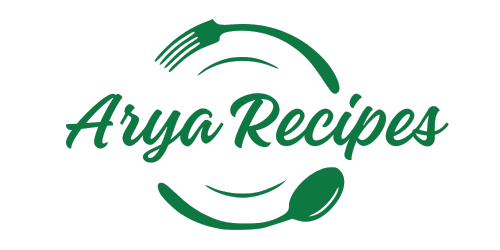Introduction
Alright, confession time—I used to think pot roast was kind of… boring. Yep, I said it. I mean, growing up, it was always this hunk of beef drowning in thin broth, and the veggies? Total mush. But let me tell you, when I finally cracked the code on how to make pot roast properly—juicy, flavorful, and coated in a rich, velvety gravy—oh WOW, game-changer.
Pot roast is one of those classic dishes that instantly makes you feel at home. It’s the star of Sunday dinners, cozy winter nights, and let’s be honest—some of the best leftovers you’ll ever eat. Plus, it’s insanely easy! Throw everything in a pot, let it do its thing, and BOOM—your house smells like a dream, and dinner basically makes itself.
The secret? A few simple but crucial tweaks. We’re talking a beautifully seared chuck roast, a braising liquid that’s got real depth, and just the right slow-cooking method to get that fall-apart tenderness. No more bland, watery nonsense—this is the pot roast that’ll change your life.
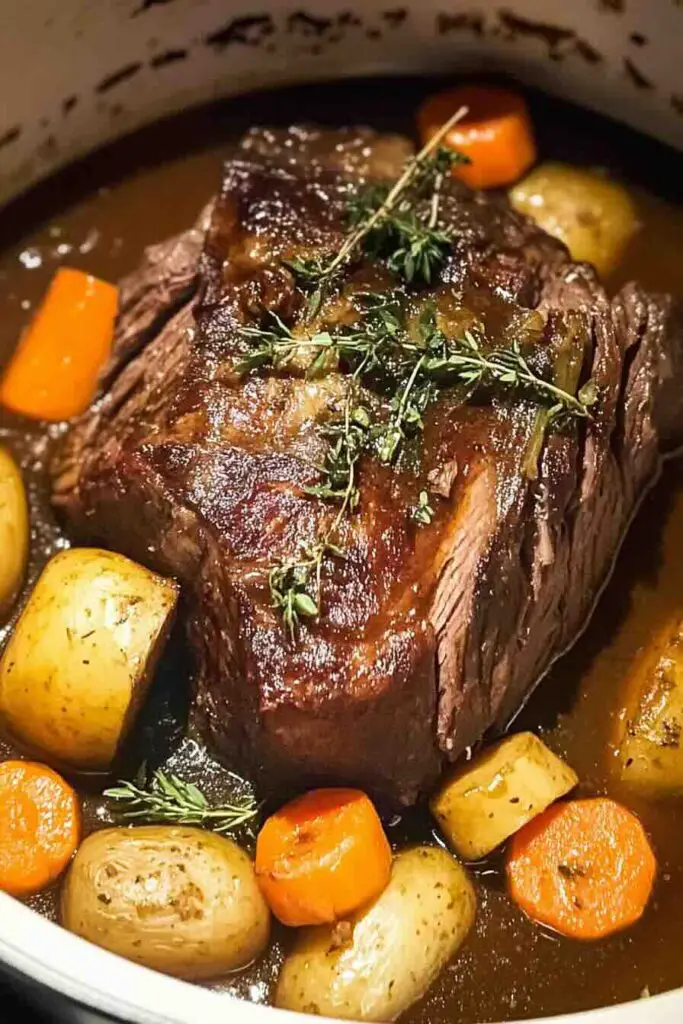
Reasons You’ll Love Pot Roast
Still not convinced? Oh, just you wait!
- Melt-in-your-mouth beef – No more chewy, tough pot roast!
- Rich, deeply flavored gravy – Thick, luscious, and perfect for drizzling over mashed potatoes.
- Minimal effort, maximum flavor – One pot does it all!
- Works with slow cooker, oven, or pressure cooker – Pick your weapon of choice!
- Tastes even better the next day – Meal prep gold right here.
Seriously, try it once, and you’ll be hooked.
What Makes a Good Pot Roast?
Choosing the Right Cut of Beef
Listen up—if you pick the wrong cut, you’re in for a tough time. Literally.
- Chuck roast – The gold standard! Super marbled, crazy tender, and perfect for slow cooking.
- Brisket – Works too! A bit leaner, but still juicy when cooked low and slow.
- Blade roast – Slightly tougher, but totally fine if cooked long enough.
Whatever you do, avoid lean cuts like sirloin—they just dry out.
The Perfect Braising Liquid
You know that rich, deep flavor you get at fancy restaurants? Yeah, that’s not just beef broth.
- Beef broth + red wine = THE combo for next-level flavor.
- No wine? Swap in extra broth + a splash of balsamic vinegar for depth.
- Want extra umami? A spoonful of Worcestershire sauce does wonders.
Cooking Methods: Slow Cooker, Oven, or Pressure Cooker?
Each method has its perks—pick what works for you!
- Slow cooker: Hands-off, foolproof, and makes your house smell amazing.
- Oven: Traditional, deep caramelization, and unbeatable depth of flavor.
- Pressure cooker: When you need pot roast now—90 minutes flat!
The Cultural Significance of Pot Roast
Pot roast isn’t just a meal—it’s a tradition.
From French pot-au-feu to Italian brasato, slow-cooked beef has been a staple across cultures for centuries. In the U.S., it’s the heart of family dinners and holiday feasts. Seriously, if you’ve never had your grandma’s pot roast on a chilly Sunday evening, you’ve missed out on a core life experience.
The History of Pot Roast
Did you know pot roast has roots in frugal cooking? Immigrants in the 19th century needed to make tough cuts of meat edible, so they turned to slow braising. Enter: the Dutch oven, the OG slow cooker! By the 1970s, slow cookers took over kitchens everywhere, and pot roast became a weeknight staple.
Ingredients
Main Ingredients
- Beef chuck roast – The star of the show!
- Carrots, potatoes, celery – Classic, hearty, and soak up all that flavor.
- Onion & garlic – Because flavor is life.
- Beef broth + red wine – Your secret weapon for rich, deep taste.
- Flour or cornstarch – For thick, silky gravy.
- Thyme, rosemary, bay leaf – The holy trinity of pot roast herbs.
Ingredient Swaps & Substitutions
- No wine? Try balsamic vinegar + extra broth.
- Want extra veggies? Toss in mushrooms or parsnips.
- Need a gluten-free version? Use cornstarch instead of flour.
Equipment Needed
Essential Kitchen Tools
- Dutch oven or slow cooker – Crucial for braising!
- Cast iron skillet – For that perfect sear.
- Fat separator – Because nobody wants greasy gravy.
Optional Tools
- Instant Pot – If you’re short on time.
- Tongs – For flipping that big ol’ roast.
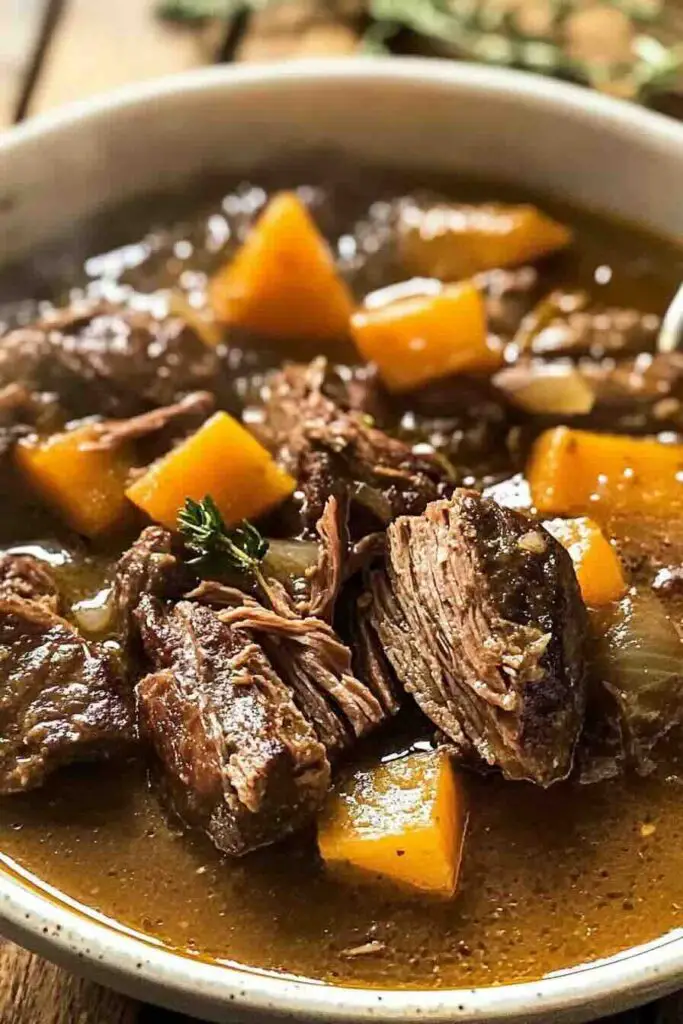
Instructions
Step 1: Preparing the Ingredients
Before you even think about turning on the stove, let’s get everything prepped and ready to go. This might seem like a small step, but trust me, it makes a huge difference in how smoothly the cooking process goes.
Start by patting the beef dry with paper towels. Why? Because moisture is the enemy of a good sear! If the surface is too wet, the beef will steam instead of browning properly. Once it’s dry, season it generously with salt and pepper. And when I say generously, I mean don’t hold back! This is a big cut of meat, and seasoning is key to making sure every bite is flavorful.
Next, chop your vegetables. Keep the carrots, celery, and potatoes in large chunks. If they’re too small, they’ll turn into mush during the long cook time. Nobody wants sad, disintegrated veggies floating around in their gravy! Onions and garlic should be roughly chopped as well—these will break down and infuse the braising liquid with their deep, savory flavors.
If you’re using fresh herbs like rosemary and thyme, tie them together with kitchen twine. This makes it easy to remove them later without fishing around for rogue stems in your gravy. Got everything chopped and measured? Great! Now, let’s get cooking.
Step 2: Searing the Beef
This is where the magic begins! Searing the beef might seem like an extra step, but it’s absolutely essential for building layers of flavor.
Heat a large Dutch oven or heavy skillet over medium-high heat. Once it’s hot, add a good drizzle of oil—something with a high smoke point, like vegetable or canola oil, works best. Carefully place the beef in the pan and let it sear undisturbed for about 4-5 minutes per side. You want a deep, golden-brown crust to form. This step is what gives your pot roast that deep, rich, restaurant-quality taste.
Be patient! Resist the urge to move the beef around too much. Letting it develop that caramelized crust locks in the juices and enhances the overall flavor of the dish. Once all sides are beautifully browned, transfer the beef to a plate and set it aside.
Step 3: Deglazing the Pan
Now comes a crucial but often overlooked step—deglazing. This is where all those delicious browned bits stuck to the bottom of the pan get lifted and incorporated into the sauce.
Turn the heat to medium and pour in your red wine or broth. Use a wooden spoon to scrape up all the flavorful bits from the bottom of the pan. This process not only adds depth to the braising liquid but also ensures that none of that precious flavor goes to waste.
Let the liquid simmer for a minute or two to cook off the alcohol if using wine. If you’re skipping the wine, a splash of balsamic vinegar or Worcestershire sauce can give you that same depth of flavor.
Step 4: Slow Cooking the Pot Roast
Time to bring everything together!
Place the seared beef back into the pot, nestling it into the flavorful liquid. Arrange the chopped vegetables around the meat, making sure they’re evenly distributed. Pour in the beef broth until the roast is about halfway submerged—this allows it to braise properly without becoming soupy.
If you’re using a slow cooker, set it to low for 8-10 hours or high for 4-6 hours. If you’re cooking in the oven, cover the Dutch oven with a tight-fitting lid and bake at 300°F (150°C) for 3-4 hours. In case using a pressure cooker, set it to high pressure for about 90 minutes, followed by a natural release.
The key here is patience. The longer it cooks, the more the connective tissues break down, making the meat fall-apart tender.
Step 5: Making the Gravy
Once the beef is fully cooked and tender, carefully remove it from the pot and place it on a cutting board. Cover it loosely with foil and let it rest while you finish the gravy.
If your sauce is too thin, mix one tablespoon of cornstarch with two tablespoons of cold water to create a slurry. Stir it into the simmering liquid and let it thicken. Alternatively, you can mash some of the cooked vegetables into the sauce to naturally thicken it.
Give the gravy a taste—does it need more salt? A splash of Worcestershire? Adjust the seasoning to your liking. Once it’s perfect, slice or shred the beef and drizzle that liquid gold over the top.
How to Tell When Pot Roast is Done
Knowing when your pot roast is ready isn’t just about watching the clock. There are a few foolproof ways to tell when it’s reached peak tenderness.
First, the fork test—this is the easiest and most reliable method. Grab a fork and gently pull at the meat. If it shreds effortlessly with little resistance, it’s done! If it’s still a bit tough, it needs more time. Pot roast only gets better the longer it cooks.
Next, check the internal temperature. The ideal range for a perfectly tender pot roast is 195-205°F (90-96°C). This is the sweet spot where the connective tissues break down completely, giving you that melt-in-your-mouth texture.
Lastly, look at the visual cues. The vegetables should be soft but not mushy, and the sauce should be rich and slightly thickened. If everything looks and smells amazing, you’re good to go!
Variations & Toppings
Recipe Variations
Pot roast is wonderfully versatile! Here are a few twists you can try:
- Spicy Pot Roast: Add a teaspoon of smoked paprika, a pinch of red pepper flakes, and a dash of hot sauce to the braising liquid for a little heat.
- Garlic & Herb Pot Roast: Use whole cloves of garlic and fresh rosemary, thyme, and sage for a fragrant, herbaceous twist.
- French-Inspired Pot Roast: Add Dijon mustard, shallots, and a splash of white wine for a more delicate, slightly tangy flavor.
Toppings & Serving Ideas
The best part of pot roast? Deciding how to serve it!
- Over creamy mashed potatoes – Classic and unbeatable.
- With buttered egg noodles – Think beef stroganoff vibes.
- Served with crusty bread – Perfect for soaking up that gravy!
For extra flair, garnish with fresh parsley, chives, or a sprinkle of grated Parmesan cheese.
Nutritional Insights
A single serving of pot roast (with vegetables) typically contains:
- Calories: ~450-550
- Protein: 40-50g
- Carbs: 20-30g (depends on potato content)
- Fat: 20-30g
If you’re looking for a lower-carb version, you can skip the potatoes and serve it over cauliflower mash.
Pro Tips & Tricks
- Sear the beef well. This step adds SO much flavor. Don’t skip it!
- Don’t rush the cooking process. Low and slow is the way to go.
- Let the meat rest before slicing. This helps it stay juicy.
- Use a fat separator for the gravy. Nobody wants greasy sauce.
- Make it a day ahead. The flavors develop even more overnight!
Storage & Health Tips
Pot roast makes amazing leftovers!
- Refrigerator: Store in an airtight container for up to 4 days.
- Freezer: Freeze in portion-sized containers for up to 3 months.
- Reheating: Warm in a covered pan over low heat, adding a splash of broth if needed.
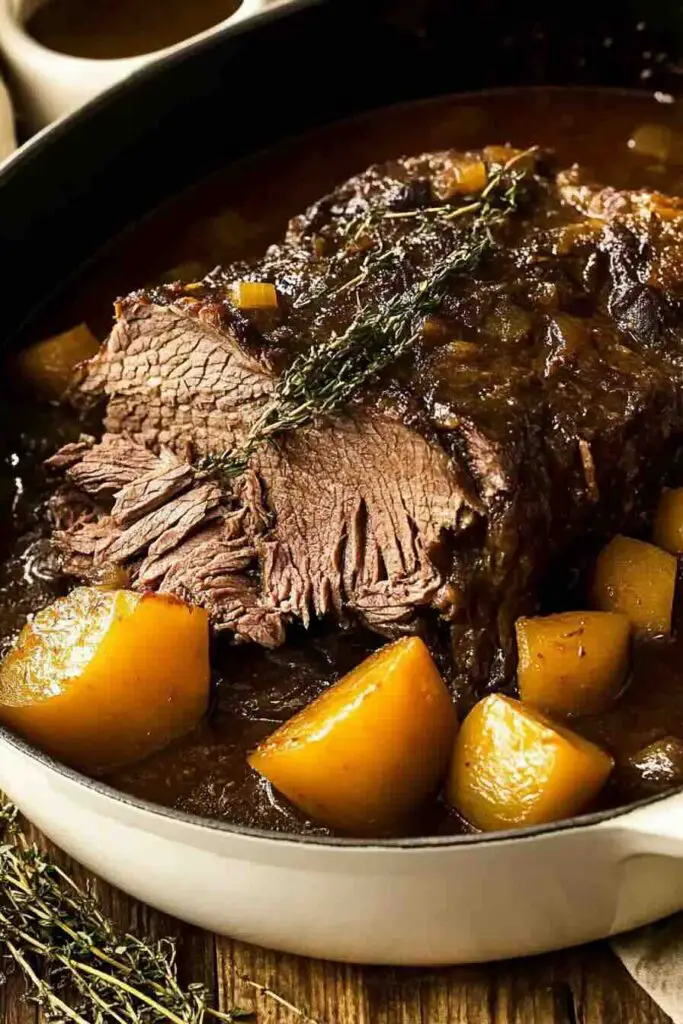
FAQs About Pot Roast
What’s the best cooking method?
The slow cooker is easiest, the oven gives the deepest flavor, and the pressure cooker is fastest.
Can I skip searing?
Nope! It makes a HUGE difference in flavor.
Should pot roast be fully submerged?
No! It should be about halfway covered in liquid.
Before You Go…
Give this pot roast a try—you won’t regret it. And if you’re on a comfort food kick, check out my Beef Enchiladas next! Oh, and let me know in the comments—what’s YOUR secret ingredient for pot roast perfection?
Happy cooking! 🥩✨
Print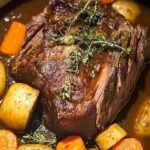
Pot Roast Recipe
- Prep Time: 15 minutes
- Cook Time: 3-10 hours (varies by method)
- Total Time: 3 hours 30 minutes – 10 hours 15 minutes
- Yield: 6 1x
Description
This pot roast recipe is the ultimate comfort food! Slow-cooked to perfection, it features tender, juicy beef, hearty vegetables, and a rich, flavorful gravy. Whether made in a slow cooker, oven, or pressure cooker, this melt-in-your-mouth pot roast will become a family favorite. Serve it over mashed potatoes, buttered noodles, or crusty bread for a cozy and satisfying meal!
Ingredients
Main Ingredients:
- 3–4 lbs beef chuck roast
- 2 tsp salt
- 1 tsp black pepper
- 2 tbsp vegetable oil
- 1 large onion, chopped
- 3 cloves garlic, minced
- 3 carrots, cut into chunks
- 2 celery stalks, cut into chunks
- 2 lbs baby potatoes, halved
- 2 cups beef broth
- 1 cup red wine (or extra broth)
- 2 tbsp tomato paste
- 1 tbsp Worcestershire sauce
- 1 tsp dried thyme
- 1 tsp dried rosemary
- 2 bay leaves
For the Gravy:
- 2 tbsp flour (or cornstarch for gluten-free option)
- 2 tbsp water
Instructions
Step 1: Prepare the Ingredients
- Pat the beef dry with paper towels and season it generously with salt and pepper.
- Chop the vegetables into large chunks for even cooking.
Step 2: Sear the Beef
- Heat oil in a Dutch oven over medium-high heat.
- Sear the beef for 4-5 minutes per side until deeply browned. Transfer to a plate.
Step 3: Sauté the Aromatics
- In the same pot, add onions, garlic, carrots, and celery. Sauté for 3 minutes until softened.
Step 4: Deglaze the Pot
- Pour in red wine (or broth) and scrape up the browned bits from the bottom of the pan.
- Stir in tomato paste, Worcestershire sauce, thyme, rosemary, and bay leaves.
Step 5: Slow Cook the Pot Roast
- Return the beef to the pot and add beef broth. Cover and cook:
- Slow Cooker: 8-10 hours on low or 4-6 hours on high.
- Oven: 300°F (150°C) for 3-4 hours.
- Pressure Cooker: 90 minutes on high pressure, followed by natural release.
- Add potatoes during the last 2 hours (slow cooker/oven) or last 20 minutes (pressure cooker).
Step 6: Make the Gravy
- Remove the beef and let it rest. Discard bay leaves.
- In a small bowl, mix flour and water into a slurry. Stir into the sauce and let it thicken.
Step 7: Serve and Enjoy!
- Slice or shred the beef, drizzle with gravy, and serve with your favorite sides!
Notes
- For extra flavor, marinate the beef overnight in a mix of broth, Worcestershire, and herbs.
- If using a pressure cooker, sauté the onions and garlic before adding liquid.
- Store leftovers in an airtight container for up to 4 days or freeze for up to 3 months.
Nutrition
- Calories: 500
- Sodium: 850mg
- Fat: 25g
- Carbohydrates: 25g
- Fiber: 4g
- Protein: 45g
